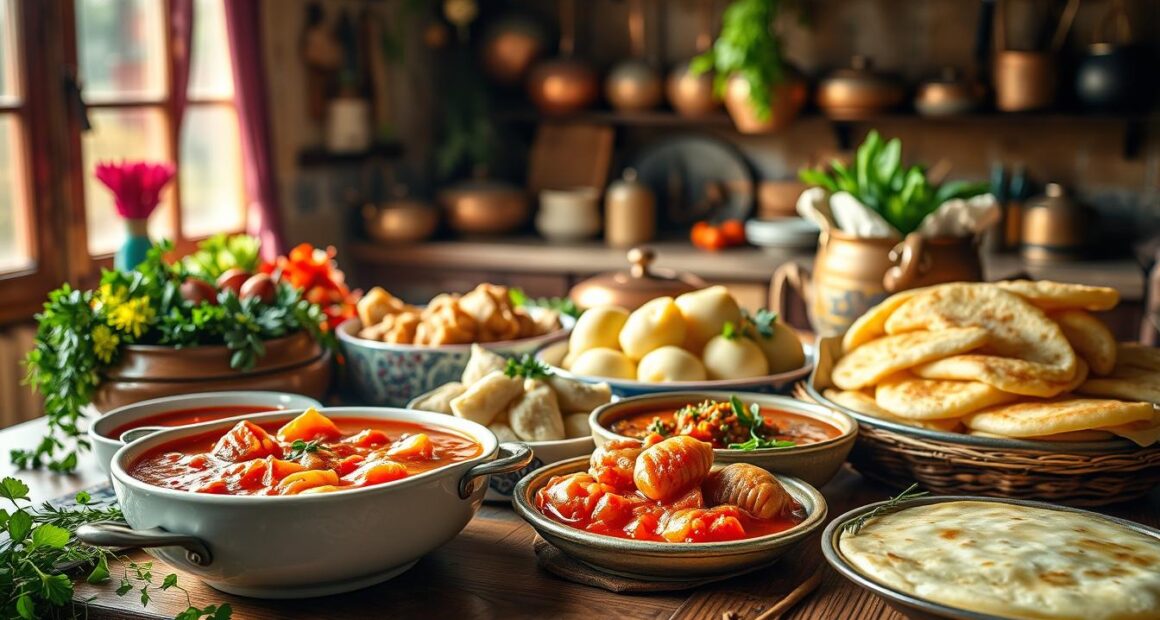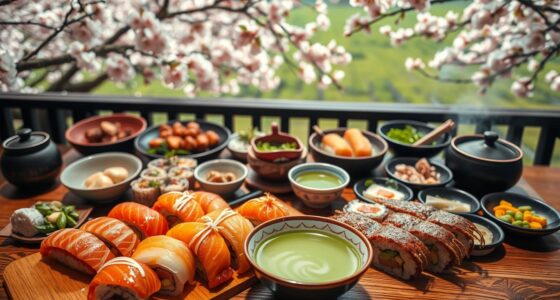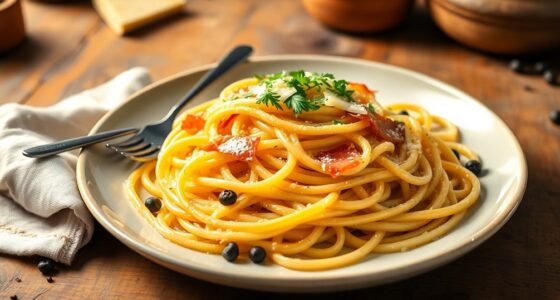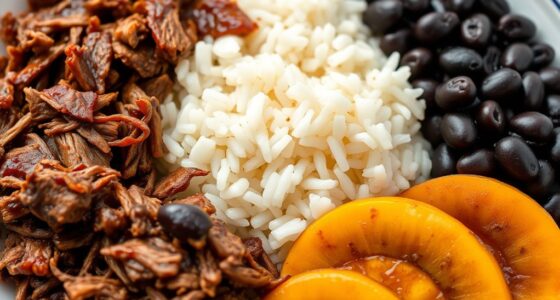Setting foot in a Ukrainian kitchen is like embarking on a heartfelt journey, one where food becomes not just sustenance but a tapestry rich with stories, traditions, and the warmth of family. Each aroma that drifts from the stove—a simmering pot of borscht, the golden crispness of potato pancakes, or the sweet scent of freshly baked syrniki—tells a tale of resilience, joy, and the enduring spirit of a nation. As you explore these culinary delights, will you find a little piece of yourself in every dish, reminding you that food has the power to connect us all, no matter where we’re from?
Ukrainian cuisine is a kaleidoscope of flavors and textures, shaped by the fertile lands that nurture its ingredients and the vibrant cultural exchanges from neighboring regions. This guide is your gateway to understanding traditional Ukrainian dishes, the best Ukrainian restaurants to savor them, and the rich layers of history that make every bite a celebration. Whether you are familiar with the hearty warmth of varenyky or intrigued by the tangy freshness of okroshka, this culinary exploration will deepen your appreciation for the soul of Ukraine.
Key Takeaways
- Ukrainian cuisine invites you to experience a diverse range of traditional dishes.
- Borscht, known for its deep flavors, originally featured up to 30 ingredients.
- Varenyky are the ultimate comfort food with versatile fillings like potatoes or cherries.
- Ukraine is often dubbed the breadbasket of Europe, producing grains fundamental to its dishes.
- Discovering the best Ukrainian restaurants can transport your taste buds to this expansive culinary landscape.
Introduction to Ukrainian Cuisine
Exploring Ukrainian cuisine reveals a rich tapestry woven from history, culture, and regional diversity. This vibrant food culture showcases thousands of recipes, making it one of the richest among Slavic cuisines. With a traditional cooking style that combines various heat treatments such as frying, boiling, stewing, and baking, the result is an array of flavors that delight the palate.
A Rich Culinary Heritage
Ukrainian culinary traditions reflect a blend of influences from various cultures. For instance, the technique of frying foods in oil has Turkic roots, while popular ingredients like pickled cabbage and homemade sausage showcase Polish origins. The incorporation of spices such as paprika and the dish “sichenyky” further highlight Hungarian and German influences, respectively. The history of Ukrainian cuisine is deeply intertwined with agricultural practices, featuring staples like potatoes, beets, onions, and cabbage.
Influences from Neighboring Countries
Ukraine’s geographical position has led to a culinary exchange with neighboring countries, enriching its food culture. Dishes like holubtsi (cabbage rolls) and varenyky (dumplings) are influenced by Turkish cuisine. Each dish tells a story of cultural adaptation, bringing together flavors and cooking techniques from various traditions. This dynamic blend not only makes Ukrainian food unique but also provides a delightful experience for anyone who dines on these cherished meals.
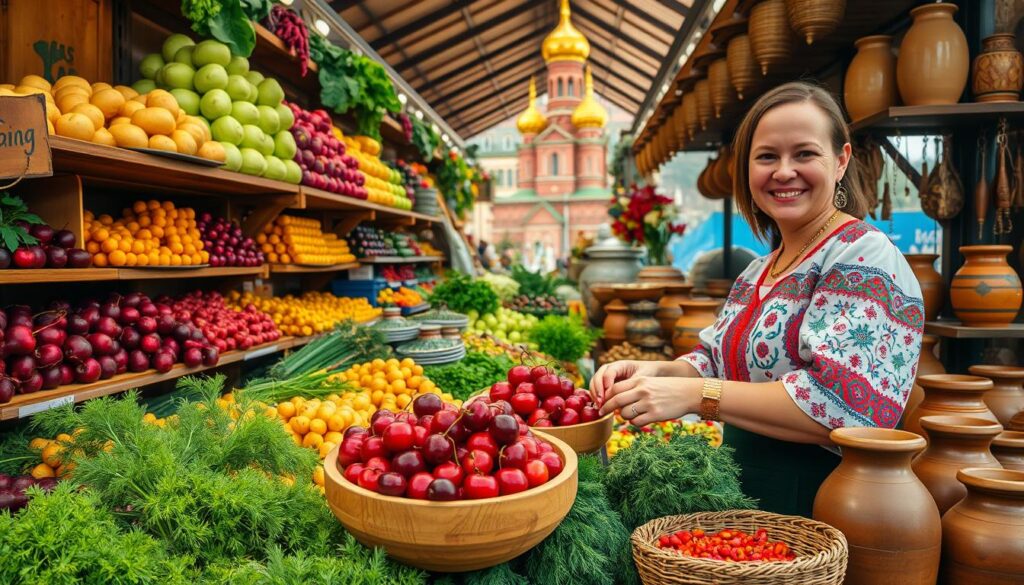
Popular Ukrainian Dishes You Must Try
Exploring authentic Ukrainian cuisine reveals an array of delightful dishes that capture the essence of the country’s rich culinary heritage. You’ll find yourself drawn to the unique flavors and comforting ingredients, which transform mealtime into a memorable experience. Below are some popular Ukrainian dishes you must try, each representing a significant aspect of the culture.
Borscht: The Iconic Beet Soup
Borscht stands tall as the national dish of Ukraine. This hearty beet soup combines rich flavors and vibrant colors, typically served with a dollop of sour cream and fresh herbs. Traditional recipes may include over thirty ingredients, showcasing the dish’s complexity and its place in authentic Ukrainian cuisine. On holidays or during everyday meals, borscht remains a beloved staple.
Varenyky: Dumplings with a Twist
Varenyky, or Ukrainian dumplings, are certainly a comfort food favorite. These soft dumplings can be filled with a range of ingredients, such as mashed potatoes, sauerkraut, sweet curd cheese, or fresh berries. Boiled or fried, their diverse fillings reflect regional tastes and family traditions, making them a quintessential part of popular Ukrainian dishes.
Holodets: A Unique Cold Dish
Holodets, or meat jelly, offers an intriguing culinary experience for anyone exploring authentic Ukrainian cuisine. This dish consists of meat broth that solidifies into a jelly-like consistency, often made with various meats and served cold. Although it might surprise some with its appearance, holodets has earned its place in festive gatherings and showcases the innovative nature of Ukrainian cooking.
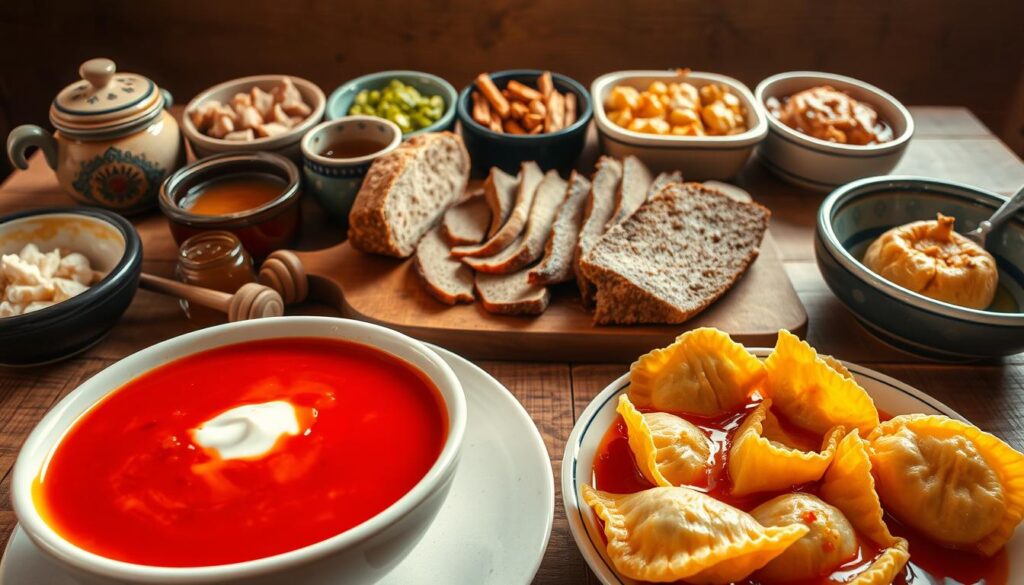
The Role of Bread in Ukrainian Meals
In Ukrainian culture, bread holds a special significance, often seen as a symbol of life, hospitality, and tradition. This importance is evident in various aspects of daily life and cultural rituals. Traditional Ukrainian dishes revolve around the use of bread, whether during major celebrations or simple family meals. It serves not just as a nutrition source but as a deeply entrenched element of Ukrainian cuisine recipes.
Paska: Traditional Easter Bread
Paska is more than just a bread; it represents a cherished tradition, especially during Easter. This cylindrical bread is baked meticulously, often adorned with intricate religious symbols. Families come together to prepare and decorate Paska, making it a delightful centerpiece for their holiday table. The preparation of Paska emphasizes the customs surrounding baking in Ukrainian culture, showcasing the skill and dedication of home bakers.
Lavash: A Staple in Everyday Life
Lavash is another essential component of Ukrainian meals, appreciated for its versatility. It serves as an accompaniment to a range of dishes, wrapping around meats and vegetables or simply enjoyed with soups. The thin flatbread not only adds texture but blends with various flavors found in traditional Ukrainian dishes. Its ease of preparation is a reflection of simplicity in home cooking, aligning well with modern Ukrainian cuisine recipes.
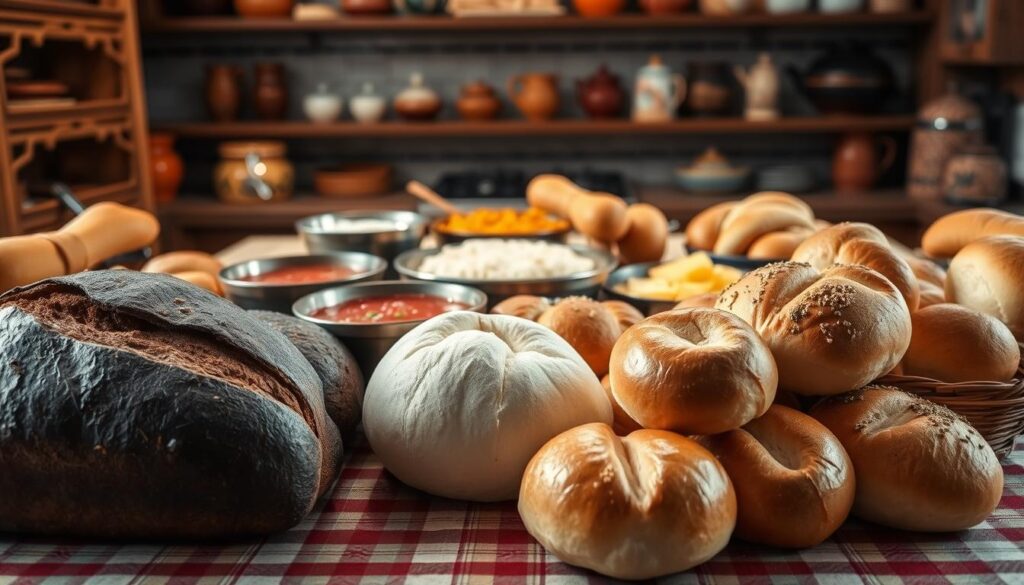
Cheesy Delights: A Taste of Ukrainian Dairy
Ukrainian cuisine showcases a delightful array of dairy products that enhance many traditional Ukrainian dishes. From desserts to savory items, these ingredients reflect the skill and artistry of Ukrainian culinary practices. Featured below are two favorites that exemplify the rich flavor profiles and textures offered by Ukrainian dairy.
Syrniki: Sweet Cheese Pancakes
Syrniki are delightful sweet pancakes made primarily from tvorog, a soft white cheese. Often served during festive occasions, especially Easter, these pancakes offer a unique twist to breakfast or dessert. Typically paired with jam, sour cream, or fresh fruits, they bring a touch of sweetness to the table. With their crispy edges and fluffy interiors, syrniki have become a must-try item in Ukrainian cuisine.
Baked Bryndza: Sheep Cheese Delicacies
Baked bryndza is another staple in traditional Ukrainian dishes, celebrating the flavors of sheep cheese. This dish involves baking the cheese until it achieves a golden crust while maintaining a creamy interior. Renowned for its distinct taste, baked bryndza can serve as a delicious appetizer or a companion to various meals. Its rich flavor not only tantalizes the palate but also reflects the deep-rooted dairy traditions in Ukraine.
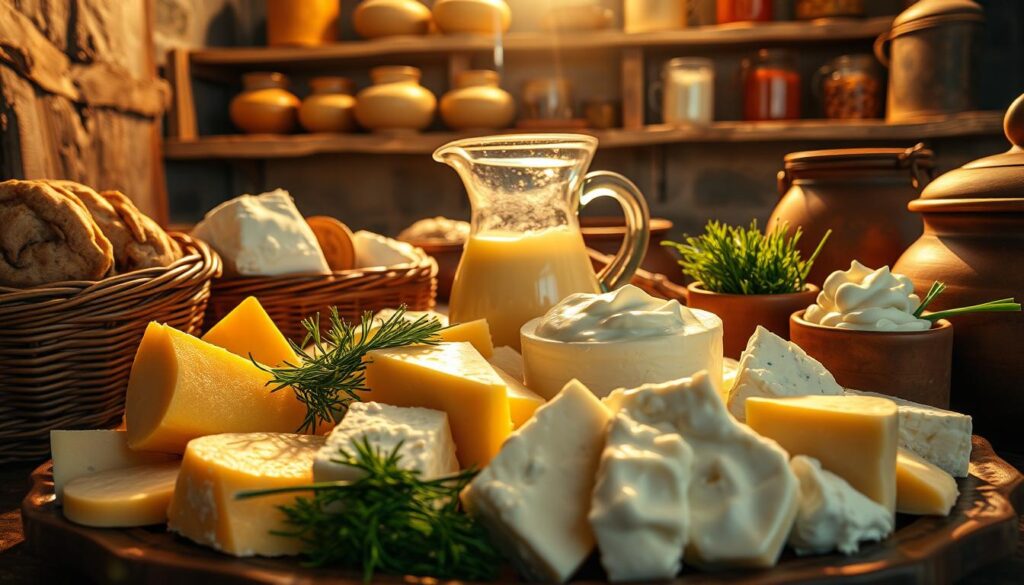
Hearty Meat Dishes in Ukrainian Cuisine
Meat plays a pivotal role in authentic Ukrainian cuisine, providing comfort and satisfaction that’s deeply rooted in Ukrainian culinary traditions. You will find that hearty dishes often feature pork, beef, and chicken, showcasing a variety of preparation methods that bring out rich flavors. Among these beloved recipes, Deruny and Kholm stand out as perfect examples of the country’s love for meat-centered meals.
Deruny: Potato Pancakes with Meat
Deruny are a delightful treat, featuring crispy potato pancakes often stuffed with seasoned meat. This dish highlights the resourceful nature of Ukrainian cooking, as families utilize commonly available ingredients to create satisfying meals. Typically made with potatoes, onions, and a hint of garlic, Deruny offers a perfect balance of textures and flavors that will have you reaching for seconds.
Kholm: Ukrainian Meat Stew
Kholm is a rich meat stew that embodies the essence of hearty Ukrainian cuisine. Utilizing affordable cuts of meat, this dish is an excellent way to create a filling meal while being budget-friendly. Slow cooking allows the flavors to meld together, resulting in a comforting stew brimming with depth and character. You can serve Kholm with fresh bread to soak up the delicious broth, making for a memorable dining experience.

The Importance of Seasonal Ingredients
In Ukrainian cuisine, the connection to seasonal ingredients is paramount. The rich chornozem soil provides a variety of fresh vegetables that flourish during the warmer months. By utilizing these seasonal products, you can experience the vibrant flavors and freshness that define traditional Ukrainian dishes.
Fresh Vegetables in Ukrainian Cooking
The heart of many Ukrainian cuisine recipes lies in the vegetables. Potatoes, cabbages, mushrooms, and beetroots dominate the palates throughout Ukraine. These vegetables are not only staples but also play a critical role in traditional meals found at the best Ukrainian restaurants. The incorporation of freshly harvested produce adds a delightful taste and health benefits to various dishes, ensuring a satisfying culinary experience.
Preserved Foods for Winter
As winter approaches, the shift to preserved foods becomes essential. Traditional methods such as pickling and fermenting allow Ukrainians to enjoy the bold flavors and nutritional qualities of their harvests all year long. These preservation techniques hold significant cultural value and create a unique array of flavors that contribute to the rich tapestry of Ukrainian cuisine. You will find that preserved foods, such as pickled vegetables, often feature as side dishes or appetizers, enhancing the overall dining experience.
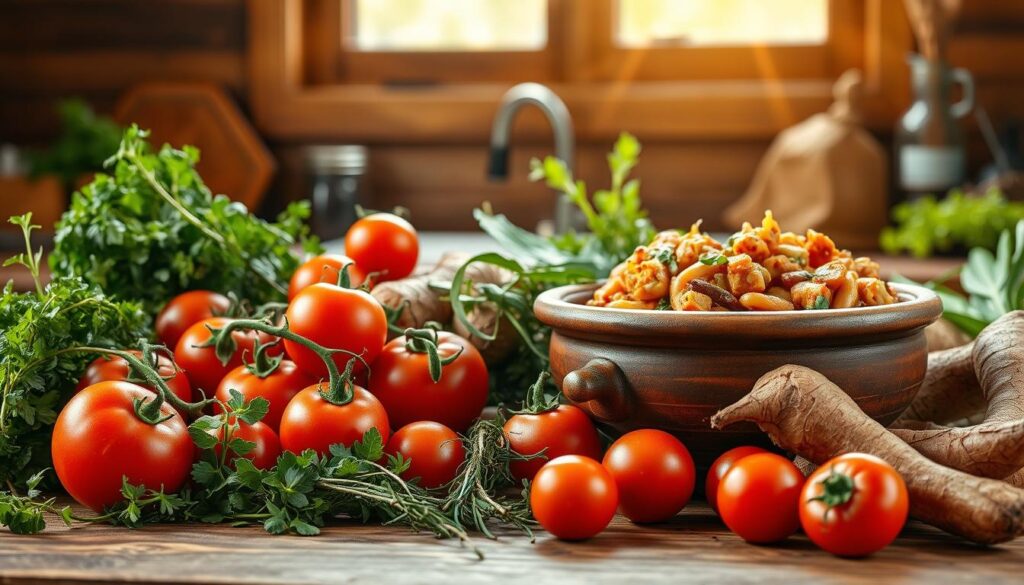
Must-Try Ukrainian Side Dishes
Exploring traditional Ukrainian dishes reveals a variety of delightful side options that elevate any meal. These side dishes not only complement the main courses but also embody the rich cultural heritage of Ukraine. From tangy pickled vegetables to hearty kasha, these additions showcase the essence of Ukrainian cuisine, highlighting both simplicity and flavor.
Pickled Vegetables: A Tangy Addition
Pickled vegetables are a staple in many homes, adding a refreshing tang that balances richer meals. Commonly made with ingredients like cucumbers, tomatoes, and beets, these pickles enhance the dining experience. Their crisp texture and vibrant flavors elevate both traditional Ukrainian dishes and popular Ukrainian dishes alike, making them a must-try for any table.
Kasha: Buckwheat as a Healthy Option
Kasha, or buckwheat, serves as a nutritious base that offers versatility in meals. Known for being gluten-free and high in fiber, it is a healthy option that pairs well with meats and vegetables. Often seasoned with herbs and spices, kasha exemplifies the agricultural roots of Ukraine while providing a wholesome side that complements various dishes.
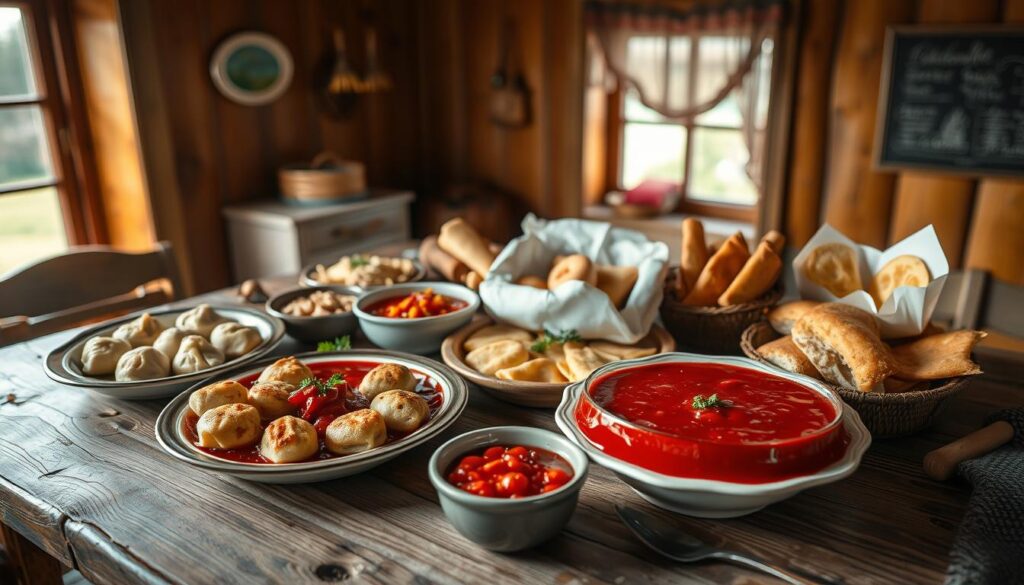
| Side Dish | Key Ingredients | Flavor Profile | Serving Suggestions |
|---|---|---|---|
| Pickled Vegetables | Cucumbers, Tomatoes, Beets | Tangy, Crisp | With main courses, sandwiches |
| Kasha | Buckwheat, Herbs | Nutty, Earthy | Alongside meats, in salads |
Sweets and Desserts in Ukrainian Cuisine
Ukrainian cuisine is not just about hearty meals; it also offers a delightful array of sweets and desserts that bring every meal to a sweet conclusion. You will find flavors and textures that highlight the use of local ingredients, making these dishes truly special. Explore traditional Ukrainian cuisine recipes that have been passed down through generations and often served in the best Ukrainian restaurants.
Medivnyk: Honey Cake Delight
Medivnyk, a cherished honey cake, showcases the simplicity and richness of Ukrainian desserts. This cake is made using just a few basic ingredients, including honey and all-purpose flour, making it a staple in many households. The sweetness of honey complements the cake’s flavor, creating a delightful treat enjoyed by many.
Pampushky: Sweet Doughnuts Filled with Jam
Pampushky are sweet doughnuts that add a delightful touch to any occasion. These doughnuts are typically filled with fruit jam, providing a burst of flavor with each bite. Found in numerous bakeries, pampushky are often enjoyed during festive gatherings and regular family meals. The combination of soft dough and sweet filling makes them irresistible.
| Dessert | Main Ingredients | Preparation Time |
|---|---|---|
| Medivnyk | Honey, all-purpose flour | Approx. 1 hour |
| Pampushky | Flour, fruit jam | Approx. 45 minutes |
| Khrustyky | All-purpose flour, sour cream | Approx. 30 minutes |
| Varenyky | Flour, sweetened cheese or fruit | Approx. 1 hour |

Each dessert reflects the unique culinary traditions of Ukraine, turning every recipe into a celebration of taste. Locating authentic versions of these dishes is easy when exploring the best Ukrainian restaurants, where you can savor every sweet note in genuine hospitality.
Celebrating Special Occasions with Food
In Ukrainian food culture, celebrations go hand in hand with festive meals that showcase the heart of authentic Ukrainian cuisine. Family gatherings and holidays often feature lavish spreads that strengthen bonds and foster a sense of community. Traditional feasts are not just about the food; they symbolize heritage, love, and togetherness, all seasoned with the notes of cultural traditions.
Traditional Feasts: Holidays and Gatherings
Ukrainian celebrations are filled with a variety of dishes, particularly during Orthodox Christmas which begins on January 6 and concludes with the Feast of Epiphany on January 19. Christmas Eve, or Holy Eve, is especially significant, where families prepare 12 meatless dishes to observe the last day of fasting. The centerpiece of the evening is typically Kutya, a porridge made from whole wheat grains, poppy seeds, honey, and nuts.
Meals might also include beloved staples like borscht, potato pancakes, and delightful Ukrainian cookies. Such occasions encourage families to gather, share stories, and enjoy the comforting flavors that define Ukrainian culinary traditions.
Family Recipes Passed Down Through Generations
Many Ukrainian families treasure recipes that have been passed down through generations, ensuring that loved ones stay connected to their roots. These cherished dishes reflect personal histories while highlighting the importance of family traditions. With celebrations like Christmas, Oksana, and Olha, two recent immigrants, embrace their culinary heritage while adapting to their new lives. As they prepare their favorite meals, they keep the spirit of home alive, sharing comforting flavors with their children and making new memories in their adopted country.
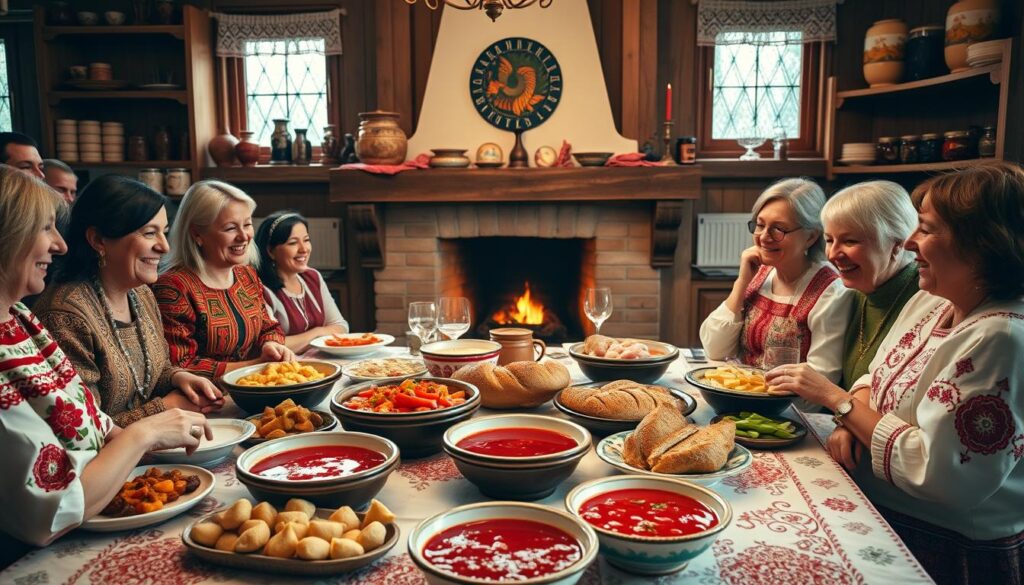
Ukrainian Beverages to Complement Your Meal
When enjoying Ukrainian cuisine, the right beverages elevate the dining experience. These drinks not only offer refreshing flavors but also showcase the rich traditions behind Ukrainian culinary practices. Two prominent beverages represent the essence of Ukrainian culture: compote and horilka. Each brings a unique taste that enhances traditional Ukrainian dishes.
Compote: A Refreshing Fruit Drink
Compote is a beloved drink in Ukraine, crafted by boiling various fruits. Often served chilled, it stands out for its delightful sweetness and refreshing qualities. Commonly made with ingredients like strawberries, apples, or cherries, compote provides a natural pairing for many traditional Ukrainian dishes, making it an essential part of meals.
Horilka: The Spirit of Ukraine
Horilka, a traditional Ukrainian vodka, boasts a rich history stretching back to the 14th century. This spirit is woven into the fabric of celebrations and communal gatherings. Often enjoyed alongside dishes such as salo, borscht, and pickled vegetables, horilka enhances the experience of savoring authentic flavors. Toasting with phrases like “Bud’mo” (To health!) captures the hospitality and warmth found in Ukrainian culture.
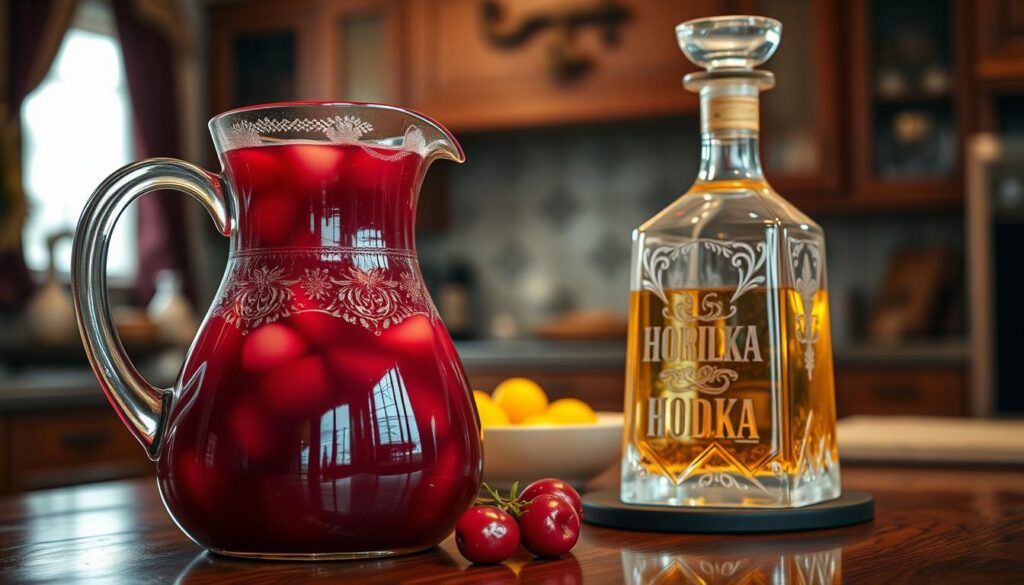
| Beverage | Description | Pairs Well With |
|---|---|---|
| Compote | A sweet drink made by boiling fruits, served chilled. | Borscht, Varenyky, Holodets |
| Horilka | A traditional Ukrainian vodka enjoyed during celebrations. | Salo, Pickled vegetables, Meat dishes |
Eating Etiquette in Ukraine
Understanding the dining customs of Ukraine reveals much about its rich Ukrainian food culture. Approaching a meal here involves following particular table manners and traditions that highlight hospitality and respect for those sharing in the experience. Engaging in meals is not just eating; it is an opportunity for connection and community, embodying the essence of traditional Ukrainian dishes.
Table Manners and Customs
Ukrainian dining etiquette emphasizes thoughtful practices. Guests are offered the best seating, and the oldest or most honored individual is typically served first. Accepting food is seen as a sign of appreciation, while refusing it can be perceived as disrespectful. It’s common to encourage guests to take seconds, reflecting the warm spirit of hospitality.
- Toasts are significant during meals, particularly when three or more people gather, with a favorite toast being “Na zdrovya” (to your health).
- When toasting, keep glasses no more than two-thirds full.
- Do not refill your own glass; allowing others to serve you is a matter of etiquette.
- Leaving food on your plate may suggest disinterest in the meal, so finish what’s on your dish.
- Bringing gifts like a bottle of alcohol or cake is customary when visiting a home.
Importance of Sharing Meals
Sharing meals in Ukraine transcends mere nourishment; it fosters connections and builds community. Dining experiences are often lengthy, filled with multiple courses and lively conversation. Guests enjoy various dishes, starting with salads and progressing to meat or fish, ending with desserts paired with tea or coffee. The meal ends with a final toast, “Na Konya!”, marking an affectionate farewell to the gathering.
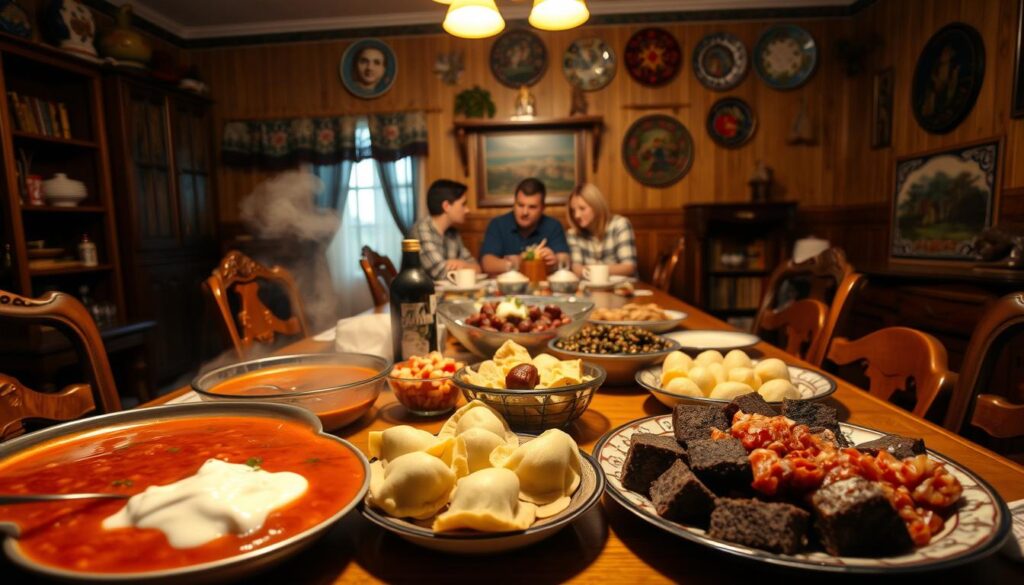
Exploring Regional Variations of Ukrainian Cuisine
Ukrainian cuisine showcases a delightful variety of flavors and ingredients rooted in its diverse regions. From the rugged Carpathians in the west to the fertile plains in the east, each area boasts unique dishes that reflect local ingredients and traditions. Engaging with these regional specialties allows you to experience the depth and richness of authentic Ukrainian cuisine.
Western Ukraine: A Unique Flare
In Western Ukraine, dishes like banush take center stage, often complemented by rich sauces made from local cheese and mushrooms. This region emphasizes ingredients like fermented foods and hearty grains, highlighting its position as a cultural crossroads. The best Ukrainian restaurants serve these traditional dishes alongside vibrant local produce.
Eastern Ukraine: Heartier Flavors
Contrasting the west, Eastern Ukrainian cuisine leans into heartier flavors that celebrate the agricultural bounty of the region. Salo, a cured pork fat, is a staple, often enjoyed with fresh bread and garlic. Signature dishes such as holubtsi and borscht reflect a robust culinary heritage that cherishes simplicity and nourishment. Restaurants in this region pride themselves on serving authentic Ukrainian cuisine with the comforting appeal of home-cooked meals.

| Region | Signature Dishes | Key Ingredients |
|---|---|---|
| Western Ukraine | Banush, Varenyky, Kapusnyak | Corn, Potatoes, Mushrooms, Cheese |
| Eastern Ukraine | Borscht, Holubtsi, Salo | Beetroot, Pork, Cabbage, Grain |
Exploring these regional variations will deepen your appreciation for the best Ukrainian restaurants. Each dish tells a story of tradition, hospitality, and the land itself, inviting you to share in this culinary journey.
Cooking Techniques Unique to Ukrainian Cuisine
Ukrainian cuisine recipes stand out due to their use of distinctive cooking techniques that enhance flavor and preserve tradition. From the time of the Kyivan Rus, food preferences demonstrated a reliance on local produce and methods that reflect the country’s rich culinary heritage. As you explore traditional Ukrainian dishes, you will discover how slow cooking and fermentation play significant roles in crafting flavorful meals.
Slow Cooking: Enhancing Flavors
Slow cooking offers a unique way to develop complex flavors in traditional Ukrainian dishes. This method is perfectly suited for stews and soups, such as the iconic borshch. Utilizing the traditional stove (pich), Ukrainian households have long embraced boiling and stewing as basic cooking methods. Some classic examples include:
- Kulish: A hearty porridge often made with grains and meats, slow-cooked to perfection.
- Holodets: A unique cold dish often prepared using slow-cooked meat and broth.
- Traditional Soups: Including various ingredients, soups are a staple, prepared daily in many households.
These slow-cooked meals create comforting experiences, fostering a sense of community around the dining table.
Fermentation: Preserving Tradition
Fermentation introduces a unique array of flavors to Ukrainian cuisine. This method not only preserves food but also reflects a long-standing culinary practice within the culture. Dishes such as fermented vegetables, which include pickled cabbage, beets, and cucumbers, are essential components of Ukrainian meals. The use of fermentation can bring distinctive character to your culinary creations. Among noteworthy fermented items are:
- Kvas: A bread-based beverage enjoyed widely, perfect for accompanying meals.
- Uzvar: A traditional drink made from dried fruits, further illustrating fermentation’s role in flavor development.
- Lacto-fermented Vegetables: Ensuring a tangy depth in flavors, these can enhance salads and side dishes.
As you create your own Ukrainian cuisine recipes, consider incorporating these techniques to enrich the flavors and textures of your meals. These practices highlight the ingenuity and resourcefulness of traditional Ukrainian dishes, showing a commitment to preserving culinary legacy.
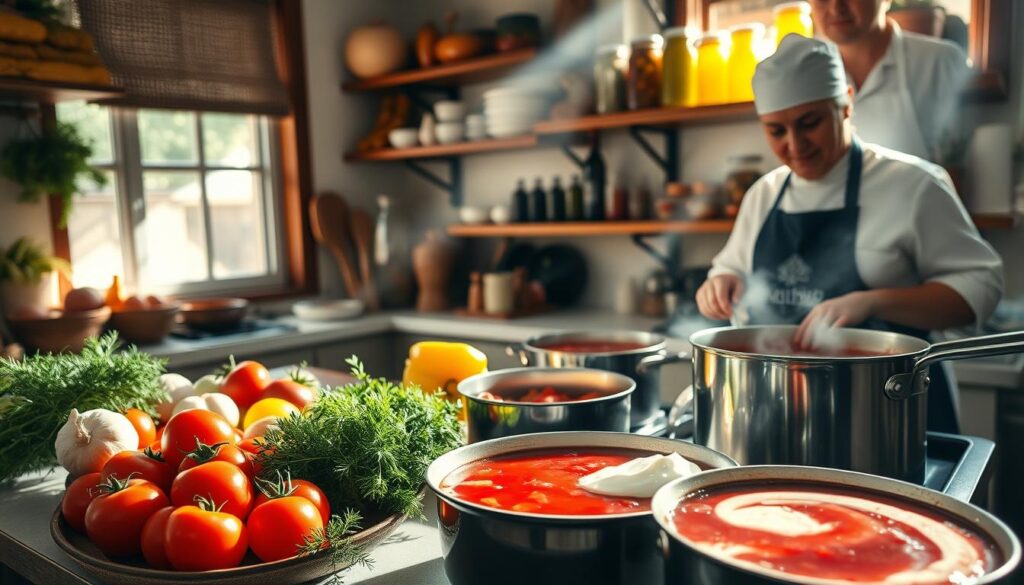
Where to Find Authentic Ukrainian Cuisine in the U.S.
Exploring authentic Ukrainian food in the United States is an exciting adventure for your taste buds. From vibrant local restaurants to bustling food festivals, opportunities abound to savor traditional dishes. You can enjoy homemade tastes and vibrant flavors reminiscent of Ukraine right within your community. For those looking to recreate these experiences, numerous online resources and apps provide valuable Ukrainian cuisine recipes, allowing you to bring the essence of this rich culture into your own kitchen.
Local Restaurants and Food Festivals
Many cities across the United States have embraced Ukrainian cuisine, showcasing it through dedicated restaurants and food festivals. Notable spots include:
| Restaurant Name | Location | Specialty |
|---|---|---|
| Veselka | New York, NY (East Village, Grand Central, Williamsburg) | Iconic Borscht and Varenyky |
| Tryzub Ukrainian Kitchen | Chicago, IL | Traditional Golubtsi and Banosh |
| Riel | Houston, TX | Ukrainian-French Fusion Dishes |
| Pierogie Kitchen | Philadelphia, PA | Authentic Pierogies |
| Magic Jug | Chicago, IL | Large Portions of Traditional Dishes |
Online Resources and Recipe Apps
For those who prefer to experiment in their own kitchens, various platforms offer an extensive array of Ukrainian cuisine recipes. Consider exploring:
- Recipe blogs dedicated to traditional Ukrainian cooking.
- Mobile apps featuring step-by-step instructions for popular dishes.
- YouTube channels with video tutorials on how to make classic recipes at home.

Cooking Ukrainian Recipes at Home
Embarking on the journey of preparing Ukrainian cuisine recipes at home offers a delightful experience filled with rich flavors and cultural insights. To successfully create traditional Ukrainian dishes, it’s essential to familiarize yourself with key ingredients and the tools necessary for authentic cooking.
Essential Ingredients and Tools
Common staples in Ukrainian cooking include:
- Cabbage
- Beets
- Poppy seeds
- Potatoes
- Various grains like buckwheat
- Unrefined sunflower oil
Having the right tools is crucial. Traditional cookware like clay pots and wooden utensils can enhance the authenticity of your meals. Additionally, familiarizing yourself with measuring tools and mixing bowls can aid in following the step-by-step guides that make cooking Ukrainian recipes more manageable.
Step-by-Step Popular Dishes
Begin with Borscht, a national dish made mainly of beets, which offers thousands of variations to explore. Next, try your hand at crafting Varenyky, the famous dumplings filled with potatoes, cheese, or seasonal fruits. For a comforting soup, Kapusniak or sour cabbage soup serves as a hearty option, and learning how to prepare it can enrich your understanding of traditional flavors.
Don’t forget to bake Paska, the Easter bread, characterized by its sweet, cylindrical shape. This showcases the importance of seasonal culinary traditions in Ukrainian kitchens. As you experiment with these dishes, enjoy the process of mixing, kneading, and folding dough, as well as the satisfaction of sharing your culinary creations with friends and family.
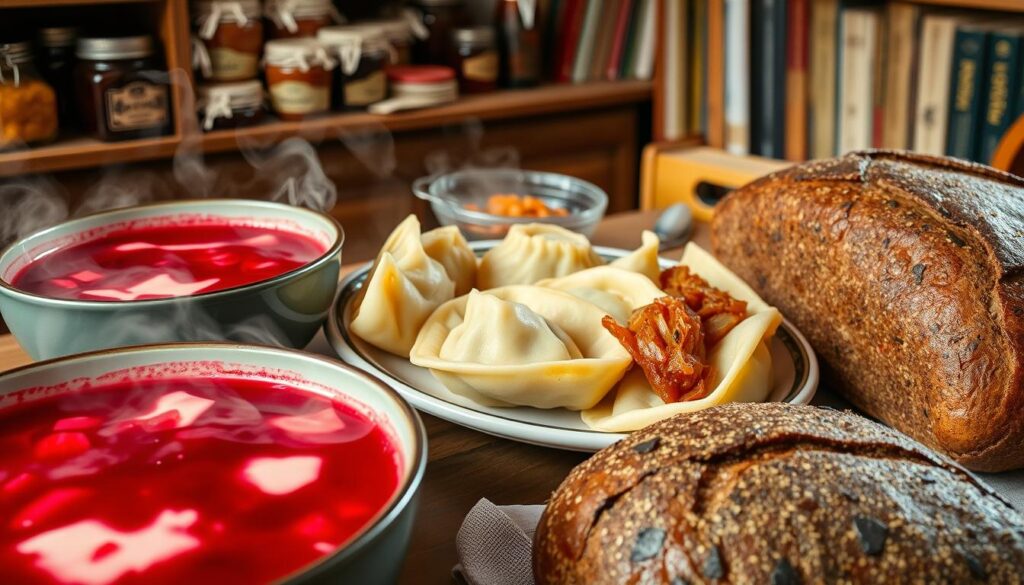
Conclusion: Embracing Ukrainian Cuisine
Embracing authentic Ukrainian cuisine invites you to connect with its rich traditions and vibrant flavors that truly deliver joy and warmth. Dishes like borscht, varenyky, and holubtsi are not just meals but are profound symbols of Ukrainian food culture that bring families and friends together. By sharing meals, whether at home or in communal settings, you set the stage for exploring new flavors while deepening your appreciation for this unique culinary heritage.
The process of making varenyky, with its various fillings and the laughter shared during preparation, highlights the importance of togetherness in creating lasting memories. The collaborative spirit embodied in these traditions showcases the nurturing environment fostered among Ukrainian families. As you engage in these cooking experiences, you also embrace the connections formed through the shared love of food.
Discovering the wonders of Ukrainian cuisine opens a door not only to delicious meals but also to understanding diverse cultures. From the comforting taste of chicken Kyiv to indulgent desserts like the Kiev Cake, each dish carries a story waiting to be shared. Ultimately, allowing authentic Ukrainian cuisine into your kitchen enriches your culinary journey, enabling you to build friendships and create unforgettable moments over the dinner table.
